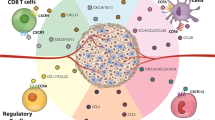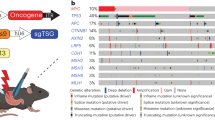Abstract
Current orthotopic xenograft models of human colorectal cancer (CRC) require surgery and do not robustly form metastases in the liver, the most common site clinically. CCR9 traffics lymphocytes to intestine and colorectum. We engineered use of the chemokine receptor CCR9 in CRC cell lines and patient-derived cells to create primary gastrointestinal (GI) tumors in immunodeficient mice by tail-vein injection rather than surgery. The tumors metastasize inducibly and robustly to the liver. Metastases have higher DKK4 and NOTCH signaling levels and are more chemoresistant than paired subcutaneous xenografts. Using this approach, we generated 17 chemokine-targeted mouse models (CTMMs) that recapitulate the majority of common human somatic CRC mutations. We also show that primary tumors can be modeled in immunocompetent mice by microinjecting CCR9-expressing cancer cell lines into early-stage mouse blastocysts, which induces central immune tolerance. We expect that CTMMs will facilitate investigation of the biology of CRC metastasis and drug screening.
This is a preview of subscription content, access via your institution
Access options
Subscribe to this journal
Receive 12 print issues and online access
$209.00 per year
only $17.42 per issue
Buy this article
- Purchase on Springer Link
- Instant access to full article PDF
Prices may be subject to local taxes which are calculated during checkout




Similar content being viewed by others
References
Ellis, L.M. Preclinical data targeting vascular endothelial growth factor in colorectal cancer. Clin. Colorectal Cancer 4 (suppl. 2), S55–S61 (2004).
Siolas, D. & Hannon, G.J. Patient-derived tumor xenografts: transforming clinical samples into mouse models. Cancer Res. 73, 5315–5319 (2013).
Sikandar, S.S. et al. NOTCH signaling is required for formation and self-renewal of tumor-initiating cells and for repression of secretory cell differentiation in colon cancer. Cancer Res. 70, 1469–1478 (2010).
Kabelitz, D. & Wesch, D. Features and functions of gamma delta T lymphocytes: focus on chemokines and their receptors. Crit. Rev. Immunol. 23, 339–370 (2003).
Youn, B.S., Kim, Y.J., Mantel, C., Yu, K.Y. & Broxmeyer, H.E. Blocking of c-FLIP(L)–independent cycloheximide-induced apoptosis or Fas-mediated apoptosis by the CC chemokine receptor 9/TECK interaction. Blood 98, 925–933 (2001).
Li, X. et al. Deconvoluting the intestine: molecular evidence for a major role of the mesenchyme in the modulation of signaling cross talk. Physiol. Genomics 29, 290–301 (2007).
Chen, H.J. et al. Chemokine 25-induced signaling suppresses colon cancer invasion and metastasis. J. Clin. Invest. 122, 3184–3196 (2012).
Ebert, M.P. et al. TFAP2E–DKK4 and chemoresistance in colorectal cancer. N. Engl. J. Med. 366, 44–53 (2012).
Meng, R.D. et al. gamma-Secretase inhibitors abrogate oxaliplatin-induced activation of the Notch-1 signaling pathway in colon cancer cells resulting in enhanced chemosensitivity. Cancer Res. 69, 573–582 (2009).
He, K., Zhao, H., Wang, Q. & Pan, Y. A comparative genome analysis of gene expression reveals different regulatory mechanisms between mouse and human embryo pre-implantation development. Reproductive biology and endocrinology. Reprod. Biol. Endocrinol. 8, 41 (2010).
Maekawa, M. et al. Requirement of the MAP kinase signaling pathways for mouse preimplantation development. Development 132, 1773–1783 (2005).
Bleul, C.C. & Boehm, T. Chemokines define distinct microenvironments in the developing thymus. Eur. J. Immunol. 30, 3371–3379 (2000).
Schneider, J.S.V.J., Terzic, A. & Fraidenraich, D. Blastocyst injection of embryonic stem cells: a simple approach to unveil mechanisms of corrections in mouse models of human disease. Stem Cell Rev. 5, 369–377 (2009).
Eds Johan Auwerx, S.L.A. et al. Current Protocols in Mouse Biology (Wiley, 2013).
Meurens, F. et al. Expression of mucosal chemokines TECK/CCL25 and MEC/CCL28 during fetal development of the ovine mucosal immune system. Immunology 120, 544–555 (2007).
Meurens, F. et al. Expression of TECK/CCL25 and MEC/CCL28 chemokines and their respective receptors CCR9 and CCR10 in porcine mucosal tissues. Vet. Immunol. Immunopathol. 113, 313–327 (2006).
Lautt, W.W. Mechanism and role of intrinsic regulation of hepatic arterial blood flow: hepatic arterial buffer response. Am. J. Physiol. 249, G549–G556 (1985).
Thiel, H. Liver hemodynamics and portacaval shunt. Surg. Gynecol. Obstet. 150, 587–592 (1980).
Walters, S. et al. Comparability of stage data in cancer registries in six countries: lessons from the International Cancer Benchmarking Partnership. Int. J. Cancer 132, 676–685 (2013).
Dancis, J. Transport of substances across perfused organs. Acta Endocrinol. Suppl. (Copenh.) 158, 347–375 (1972).
Okumura, K. et al. Correlation between chemosensitivity and mRNA expression level of 5-fluorouracil-related metabolic enzymes during liver metastasis of colorectal cancer. Oncol. Rep. 15, 875–882 (2006).
Jahid, S. et al. miR-23a promotes the transition from indolent to invasive colorectal cancer. Cancer Discov. 2, 540–553 (2012).
Yu, C.R., Peden, K.W., Zaitseva, M.B., Golding, H. & Farber, J.M. CCR9A and CCR9B: two receptors for the chemokine CCL25/TECK/Ck beta-15 that differ in their sensitivities to ligand. J. Immunol. 164, 1293–1305 (2000).
Wagner, M. et al. Effective treatment of advanced colorectal cancer by rapamycin and 5-FU/oxaliplatin monitored by TIMP-1. J. Gastrointest. Surg. 13, 1781–1790 (2009).
Nagy, A. Manipulating the Mouse Embryo: A Laboratory Manual, 3rd Edn. (Cold Spring Harbor Laboratory Press, 2003).
Chen, C., Khaleel, S.S., Huang, H. & Wu, C.H. Software for pre-processing Illumina next-generation sequencing short read sequences. Source Code Biol. Med. doi:10.1186/1751-0473-9-8 (3 May 2014).
Li, H. & Durbin, R. Fast and accurate short read alignment with Burrows-Wheeler transform. Bioinformatics 25, 1754–1760 (2009).
McKenna, A. et al. The Genome Analysis Toolkit: a MapReduce framework for analyzing next-generation DNA sequencing data. Genome Res. 20, 1297–1303 (2010).
Cao, Z. et al. Angiocrine factors deployed by tumor vascular niche induce B cell lymphoma invasiveness and chemoresistance. Cancer Cell 25, 350–365 (2014).
Acknowledgements
We thank other members of the Lipkin laboratory and Shen Laboratory for helpful discussions. We also thank the Cornell BRC imaging and Stem Cell and Transgenic Core Facilities. This work was supported by the National Science Foundation (NSF) 1137269, NSF 1106153, NSF GRFP-2011131053, National Institutes of Health (NIH) R01 GM095990, CA098626, NIH 2UL1-RR024996, NIH UH2TR000516, Defense Advanced Research Projects Agency 19-1091726, and generous donations by Matthew Bell and Fred Greenberg.
Author information
Authors and Affiliations
Contributions
H.J.C., X.S. and S.M.L. proposed the concept, designed the experiments and co-wrote the manuscript; H.J.C., Z.H., M.A., N.R., Joyce Chen, P.B., L.W., Y.X., Jonlin Chen and M.S. performed the experiments; J.S., K.Y.C. and Z.H.G. contributed to bioinformatics analyses; H.H.J., R.M., C.A. and W.E. performed blastocyst injections; N.R., D.J.J., Jiahn Choi, P.G. and N.N. performed multiphoton imaging; J.M. and G.N. provided tissue samples; R.L. performed assays for detecting immune cells; X.K.Z. performed statistical analysis; R.E. and A.D.M. performed histopathology analyses.
Corresponding authors
Ethics declarations
Competing interests
The authors declare no competing financial interests.
Supplementary information
Supplementary Text and Figures
Supplementary Figures 1–12, Supplementary Tables 1–3, Supplementary Methods (PDF 14691 kb)
Rights and permissions
About this article
Cite this article
Chen, H., Sun, J., Huang, Z. et al. Comprehensive models of human primary and metastatic colorectal tumors in immunodeficient and immunocompetent mice by chemokine targeting. Nat Biotechnol 33, 656–660 (2015). https://doi.org/10.1038/nbt.3239
Received:
Accepted:
Published:
Issue Date:
DOI: https://doi.org/10.1038/nbt.3239
This article is cited by
-
Extracellular vesicles-based pre-targeting strategy enables multi-modal imaging of orthotopic colon cancer and image-guided surgery
Journal of Nanobiotechnology (2021)
-
Interrogating open issues in cancer precision medicine with patient-derived xenografts
Nature Reviews Cancer (2017)
-
A recellularized human colon model identifies cancer driver genes
Nature Biotechnology (2016)
-
Advancements in Modeling Colorectal Cancer in Rodents
Current Colorectal Cancer Reports (2016)



